French Press vs. Pour Over Coffee(Key Differences)
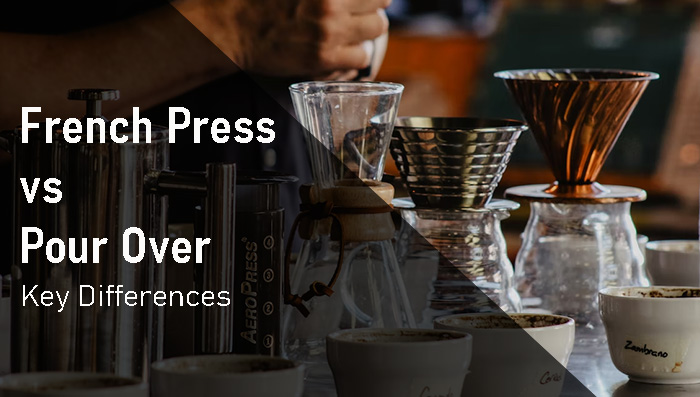
One of the fantastic perks of being a coffee lover is learning how much coffee is and about so many coffee variations, styles, or brewing methods. So, the question is, which coffee style is your favorite? The pressed one or the poured one?
In recent times, manual coffee making has become so popular that consumers prioritize homemade coffee more than the beverages available at famous coffee chains. This popularity has led many coffee lovers to invest in French presses or pour-over coffee makers.
Both these brewing styles make coffee very different from the drink made in an electric coffee machine.
So, here is another question. How do we compare these two methods? Which one is better? Which way is the simplest to use? And above all, which one should you invest in if considering buying a coffee maker? The French press or the pour-over?
In this article, we will learn a few key differences between the French press and the pour-over coffee method, along with their pros, cons, tips, and tricks about brewing coffee via each way. Let’s start.
What is a French press?
A staple coffee maker in many homes all around the world, a French press is the most straightforward coffee-making device ever!
Also known as an ‘immersion coffee maker,’ the French press immerses the coffee grinds into hot water for a few minutes and extracts the flavor from them.
The process is similar to the Aeropress coffee-making method but also depends on your brew recipe. However, a French press tends to produce rich, intense, and full-bodied coffee as compared to other coffee brewing processes.
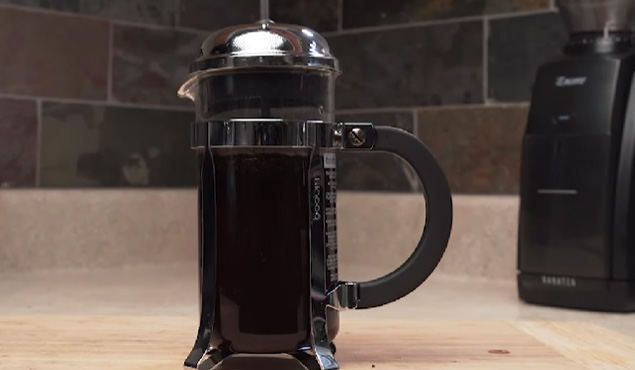
History
The French press coffee machine is known by multiple names globally. In Italy, it is called Cafeteria a Stantuffo, while in Australia, South Africa, and New Zealand, it is called a coffee plunger. However, the name “French Press” is the most popular and originated in the United States.
Many people in the coffee world are surprised to learn that Attilio Calimani was the first person to patent the French Press in 1929. In 1852, two Frenchmen, Mayer and Delforge invented a similar brewer with a similar name.
When to use a French press?
The French press coffee brewing method makes intense, dark roast coffee. Due to a more extended roasting period, this method is the best for making the most of the coffee oil extracted from the coffee grinds.
Full-bodied and robust in both taste and texture, the best French Press coffee brewing method is genuinely superior to all other coffee brewing methods. This makes it a good choice for adding flavorings, creamers, and alcohol to coffee. While other components may appear present, the quality is retained due to the stronger flavors.
How does it work?
Also known as a coffee press or cafeteria, a French press consists of three basic components with no other mechanics involved. A signature plunger, a metal filter, and an opened top cylindrical glass (carafe).
So, all you need to do is to add a measured amount of coffee beans at the bottom of the French press, pouring hot water on the top. After letting it steep for a few minutes, you can push the stainless steel metal filter top. This will move the coffee grounds to the bottom and extract the aromatic, flavorful coffee on top.
How to brew coffee in a French press?
To make cold-brew coffee in the morning brew a French press, you need to follow the following steps:
- Preheat your French press by pouring hot water into the glass container, pushing the plunger into the water, then taking the water out.
- Now, grind about 20g of coffee beans, and place them in the bottom of the French press.
- After that, pour hot, boiling water into the machine, ensuring that all the coffee grinds are immersed in water. Now, close the metal lid with the plunger, not dip it in hot water.
- It is now time to wait 4-5 minutes to let the ingredients steep together.
- Once the time is up, slowly push the plunger, forcing the coffee grinds to the bottom of the carafe.
- Your dark French-pressed brew is ready to drink!
Pros and Cons of a French Press
Now that you have learned what a French press is, how it works, and its traditional dark roast brew method, let us tell you a few pros and cons of this brewing process.
Advantages
- A simple machine with no complex mechanics and is easy to use even with no prior brewing experience.
- Needs one or two additional gears, like an electric coffee grinder to grind freshly roasted beans, and a kitchen scale to measure the ingredients.
- Consistent extraction leads to the same coffee texture and flavor every time you brew.
- Highly affordable, as no other costly equipment is required.
- Customizable, you can brew strong or light coffee drinks by reducing or increasing the steeping time.
- Flexible capacity: Because of its large container capacity, you can brew a single cup or make multiple delicious cups.
- No paper waste since the filter is made of stainless steel/metal.
Disadvantages
- The coffee is gritty, with coffee silts in the bottom of the cup, resulting in a bitter taste.
- Slower than other coffee machines, as the steeping requires time, thus making it non-ideal if you are rushing somewhere and need a coffee boost within a minute.
- Challenging to clean, as the coffee grounds often stick to the mesh filter and come out slowly.
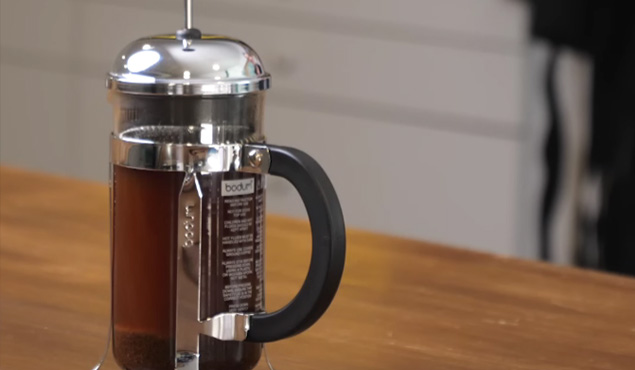
What is a pour-over?
A traditional brewing process, pour-over coffee, making fresh coffee, is gaining popularity day by day on social media. It is known as the ‘infusion brewer’ since it extracts fresh coffee from freshwater over the grounds.
The method is similar to how a manual drip coffee machine would operate. It takes a shorter time to steep the grinds and water, thus making a soft drink but brighter with a texture similar to that of tea.
In most coffee shops and home brewing contexts, pour-overs are becoming increasingly popular. Most people are attracted to this brewing method due to how well it showcases the various characteristics of different coffee beans.
Unlike French pressed coffee, the most popular way to drink pour-over coffee is black since milk, and other condiments tend to dilute their nuanced flavors when added.
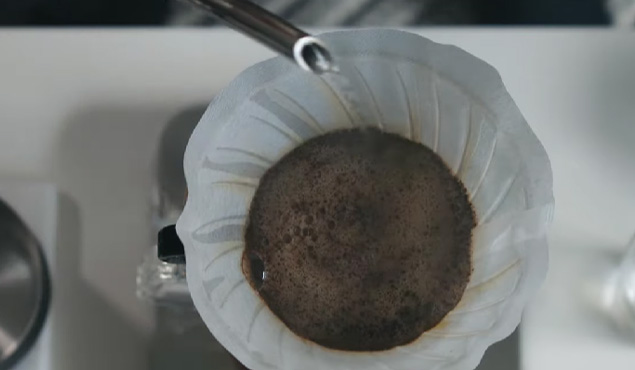
History
The pour-over coffee brewing method is believed to be as old as the beginning of the specialty coffee movement. People have used this method since buying coffee regularly in Europe in the 1900s.
However, at first, a cloth filter was used in the process. But, a German inventor Melita Bentz invented the paper filter for the pour-over process in 1908. This is why a pour-over coffee is often called a manual drip or filter coffee.
When to use a pour-over?
There is nothing better than a pour-over for light roast coffee lovers. It is particularly useful if you prefer blonde roasts since it will highlight subtle coffee flavors with more flavor notes and aromas.
It is not just the flavors that are lighter but also the texture or mouth feel of a pour-over coffee. Due to a shorter contact time between the water and the coffee grounds, it does not thicken the finished brew as much as it does with a French press.
How does it work?
The pour-over method involves placing coffee grounds in a pre-wet, cone-shaped container and pouring boiling water over them. The coffee grounds sit on top of the cylindrical cone.
When the water is poured over the grinds, the paper filter causes the liquid to infuse with the coffee grounds in a circular motion, thus brewing quickly. This results in a lighter, creamier, smooth-textured coffee with no grits or silts.
How to brew coffee in a pour-over?
Compared to French press brewing, pour-over brewing is more complicated and technical. It takes time and experience to make coffee pour–overs well. Following are the basic steps to make a pour-over coffee:
- The first step involves pre-wetting the coffee maker and the paper filter by boiling about 400 gms of water, unfolding the filter, and placing it on the cone top.
- Now, pour the hot water in a circular motion, which passes through the paper filter into the carafe (glass container). Once pre-wetted, dispose of off the water.
- Next, grind about 18-20 gms of coffee beans, and place them in the filter.
- It is now time to bloom the coffee by adding hot water (around 50 gms) in a spiral motion. Wait for 30-40 seconds for the blooming phase to end.
- Now, pour hot water (230 gms more) in 3-4 stages, and wait for it to drain for about 3-4 minutes.
- Your coffee is ready to serve. Stir it a little bit, and you are good to go! Dispose of the grinds and the paper filter.
Pros and cons of Pour-over
Here are some advantages and disadvantages of the pour-over coffee-making method.
Advantages
- Results in a perfect cup of light intense, bright drink that many beginning coffee drinkers love to enjoy.
- It produced a soft and very clean coffee cup, which most coffee lovers prefer. Thanks to the thick paper filter, that makes absolutely no grit or silts in the coffee grounds.
- The pour-over is the easiest to clean, unlike the French press. Simply dispose of the paper filter and the coffee grinds, and you are all set!
- The paper filters and cones are highly affordable. Even cheaper than a French press.
- Unlikely to break, it can be used for a lifetime!
- Makes 1-3 coffee cups at a time!
Disadvantages
- Requires brewing experience, as pouring the water in a swirl motion is not a piece of cake, especially for beginners.
- The pour-over does not do well in large settings, as the capacity is only capable of making 1-2 coffee cups at a time. However, some pour-overs, like the Bodum and Chemex, have larger brewing capacities.
- Brewing takes a little longer, so it is definitely not for the ones who love instant coffee on the go!
- With poor technique, they tend to produce inconsistent flavors.
- Lack of intense flavor notes, as many people often prefer rich extreme coffee drinks and get disappointed with a soft and subtle flavor.
Pour-over also requires additional gears like a gooseneck kettle, cylindrical cones, and filter, which can add up to the price, unlike the French press.
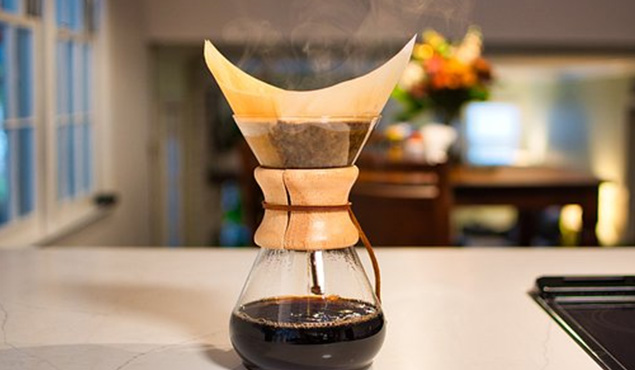
Tips and Tricks For French-pressed and Pour-over Coffee Methods
French Press Method:
- It is recommended that you bring your water to a temperature of 200°F. Alternatively, if you don’t have a thermometer, bring your water to a boil (212°F) and let it cool slightly before adding the ingredients.
- All brewing methods should be done with fresh, filtered water. Tap water contains minerals, chlorine, and other unpleasant tastes.
- Approximately 7 to 8 grams of ground coffee per cup of water (6.7oz) will be needed.
- Using medium to dark roast beans in your French press is best.
- As beans are roasted, their natural oils become more visible and flavorful. French presses are especially suitable for this.
- To minimize the grits, use a coarse grind similar to the texture of coarse sea salts. This size of the grounds will not be able to pass through the metal filter.
- Wait 30 seconds or more to let the coffee grinds settle at the bottom before plunging. Doing this will prevent maximum grits from ending in your final cup.
- You can also use a second filter when pouring the coffee into your cup. This method will work wonders and catch maximum grit, thus delivering a smooth coffee cup!
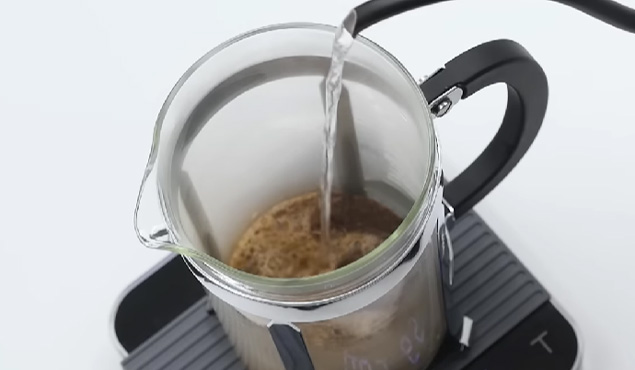
Pour-over method:
- You can pour water out of a gooseneck kettle. These kettles have thin spouts that let you pour water more quickly.
- Use light roast beans to produce coffee with the pour-over method.
- Always pour water from the kettle at the same height and with the same flow. As a result, the grinds will be extracted evenly.
- The grinds must be immersed in water at all points of the coffee brewing process.
- Do not let the grinds dry out during the pouring stage when the water level recedes. Dry patches can lead to uneven extraction, thus delivering a poor-flavored coffee cup.
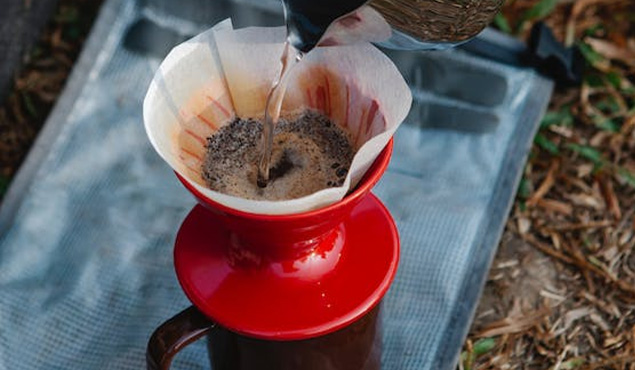
French press vs. Pour over: what are the key differences?
Let us compare the two brewing methods and learn about their key differences.
Brewing method
The brewing method used by a French pressed coffee maker is the immersion process, in which the grounds are immersed in water and then pressed to the bottom with the help of the plunger.
The grinds are then left to steep for a few minutes in the water, extracting out the following soluble:
- Lipids and fats
- carbohydrates
- sugar
- caffeine
- acids
- natural coffee oils
On the other hand, pour-over is an infusion brewing method that works on the water flow and gravity. You must constantly add fresh hot water all over the coffee grinds to extract all the grounds and soluble from them.
How much time do you have for your coffee?
One of the most significant differences between the French press and pour-over coffee is their brewing time.
So, if you are looking for a quick, delicious, fresh coffee, a French press is an ideal option. This coffee-making method is faster than a pour-over coffee process and takes about 6-7 minutes to brew.
However, if you have enough time and want a clean, grit-free coffee cup, you should opt for the pour-over method, as it uses the drip process, which takes longer, and require constant water pouring inside the filter. The pour-over coffee takes about 8-12 minutes to brew.
Coffee quality and taste
Let’s talk about the taste and quality of each method one by one.
What does French-pressed coffee taste like?
The coffee brewed by the French press method produces coffee that has a distinctive taste to other traditional coffee-making methods.
- Rich and bold: The intense flavor of the four-minute brew via French press is unmistakable. Although it may be challenging to identify the most nuanced flavors in the drink, the full, robust flavor cannot be ignored.
- It is also a full-bodied coffee: This is due to the metal filter that allows the micro grits from the coffee grounds to slip into the cup, giving the coffee an intense and heavy mouthfeel.
- It has a muted acidity: Due to micro-grounds, French press coffee often seems less tangy because your tongue cannot taste the coffee’s natural oils and acids.
Due to all the natural oils in a French press vs. pour micro coffee grinds sinking to the bottom of the cup, the last couple of sips feel gritty or sludgy despite the good taste. This is the most prominent thing about the French press that causes 99% of coffee lovers to dislike it.
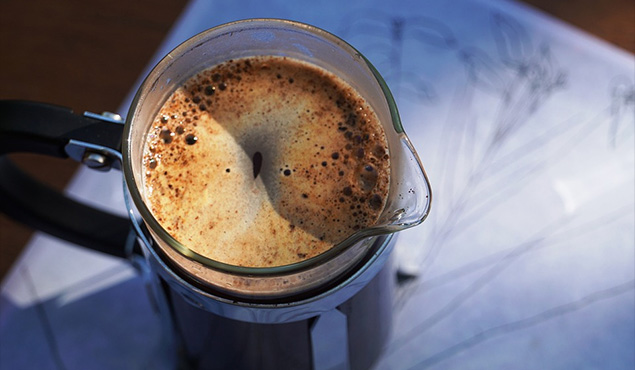
What does the pour-over coffee taste like?
The coffee taste from the pour-over method is more similar to a traditional espresso with more balanced flavors.
- Nuanced and clear: As a result of the faster brew time and the paper filter, the coffee has a high level of flavor clarity, and the most subtle flavors and aromas can be tasted easily.
- Clean and light: Often, pour-over coffee has a light, clean mouthfeel since micro-grounds cannot pass through the paper filter. A smooth cup of coffee with no grit or sludge.
- It has a brighter acidity: With no micro-grounds on your tongue, you can taste all the other flavors more clearly.

Build quality and material
The build quality and the materials used in the French press and pour-overs depend upon their cost.
It is predominantly glass used in French Presses and pour-over coffee makers. The options are more expensive because they are of higher quality. Finding less expensive coffee makers is also possible, but the glass will be of lower quality.
However, nowadays, both coffee brewers can also be made of heavy-duty plastic. But, it is not recommended since plastic is not a healthy option at all, primarily when used with hot water.
Ease of use
One of the most incredible things about these coffee makers is that these devices are straightforward and simple to use. You do not have to be a decade-old, experienced barista to brew a cup of coffee in the pour-over or French press coffee maker.
However, when it comes to French press vs. pour-over, the latter is far simpler to use since it does not require any brewing experience, and no additional gears are attached. You can never go wrong in brewing a really delicious cup of coffee with a French press.
On the other hand, the pour-over method is also easy but requires a few skills to be able to pour the water into the carafe in a spiral motion. Just a little bit of practice, and you are good to go!
Cleaning and maintenance
Pour-over coffee makers are extremely easy to clean. Paper filters go in the trash, and carafes are washed.
It’s a little more complicated with French Press. Coffee particles can get stuck in the strainer, making it difficult to clean. After brewing, however, you should rinse and wash the strainer right away so that the coffee grounds do not stick to the metal mesh filter.
The bottom line: Which one should you buy?
There you have it! We hope that you have learned everything about French press and pour-overs. Now, the next step is to determine which coffee maker suits your tastes and lifestyle based on your understanding of how these coffee makers work and deliver what type of coffee.
Go for a French press brewing method if:
- You like a rich, full-bodied coffee cup.
- You want your daily morning coffee, but not a too hands-on machine.
- You want to brew multiple cups at a time.
- You like to have a cold brew coffee.
Go for a pour-over brewing method if:
- You want to learn exceptional water-pouring skills.
- You like clean, exotic, or complex coffee flavors.
- You can wait longer to brew your morning coffee.
- You like to make flash-chilled iced coffee.
- You want to save time cleaning afterward.
FAQs
Is coffee from a French press healthy?
French press coffee should not harm your health if you drink one to four cups per day. However, people with caffeine sensitivity, heart conditions, pregnancy, or medications that affect blood cholesterol should consume less caffeine.
What is the golden ratio for the French press?
A 1:12 coffee-to-water ratio is ideal for the perfect cup of French press coffee. It will take about one and a half cups of water and 30 grams of coffee to make this recipe.
Is it OK to drink French press coffee every day?
You must monitor your cholesterol levels to prevent your LDL levels from rising over time. Stick to four cups of pressed coffee daily to control your habit. In addition, you should limit the amount of filtered coffee you drink per day to five cups.
How long do you let the French Press steep?
To make a perfectly fresh cup of French-pressed brewed coffee, you must wait to plunge it before time. Let the water and coffee ground steep together for about four minutes to extract all the flavors, and then you can stir the final brew and serve!
What is the difference between a pour-over and drip coffee?
The drip coffee maker is an automatic machine that pours water over ground coffee. By using it, you won’t always have to pour coffee over water yourself. Pour overs are manual coffee makers, and pouring coffee made automatically does have a distinct taste from the latter. The pour-over coffee has a more flavorful taste than the automatic drip coffee.
Can you use regular ground coffee for pour-over?
Yes, you can. However, if you want to make your brewed coffee taste its best, use your own freshly roasted beans. You can tell a world of difference by it. A medium-coarse grind is best for pour-overs, but you can also go finer or coarser. It all depends on what you like in coffee.
